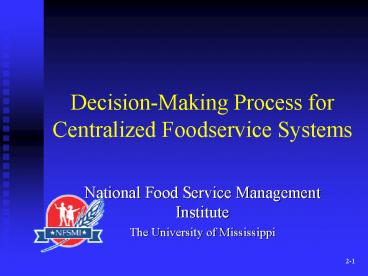Decision-Making Process for Centralized Foodservice Systems PowerPoint PPT Presentation
1 / 21
Title: Decision-Making Process for Centralized Foodservice Systems
1
Decision-Making Process forCentralized
Foodservice Systems
- National Food Service Management Institute
- The University of Mississippi
2
Trends
- Change in menu items
- Increase food safety concerns
- Growth rapid in some school districts
- Increase in labor costs
- Limit in labor availability in some areas
- Increase in diversity among employees
3
Factors Influencing Decisions to Centralize Food
Production
- Growth in school district
- Need for control of quality and consistency
- Financial savings
- Labor
- Food
- Building and equipment costs
4
Factors, cont.
- Facility limitations
- Labor availability
5
Decision-Making Process
6
Options for Centralizing
7
Accomplishing Goals
8
Case Study
- The Springvale School District, located
- adjacent to a major metropolitan area, has
- experienced major growth over the past three
- years and is expected to continue to grow for
- at least the next 5-8 years. It is expected that
- several new schools will be built in the next
- 5 years to meet the needs of the district. What
- decisions do you make as the district foodservice
- director?
9
Step 1. Identify and Define Problem
10
Step 1. Identify and Define Problem
- Growth
- Cost containment
- Labor availability
11
Step 2. Identify Alternatives
12
Step 2. Identify Alternatives
- Continue on-site foodservice system
- Form regional kitchens
- Centralize some cooking functions such as baking
- Build a central kitchen
13
Step 3. Evaluate Alternatives
14
Step 3. Evaluate Alternatives
- Building/renovating costs
- Equipment costs
- Operating costs
- Labor availability
- Menu impact
- Acceptance by community/students
15
Step 4. Select Best Alternative
16
Step 4. Select Best Alternative
- Consider issues identified in Step 1
- Consider needs of the district
- Develop and review feasibility study
- Criteria-based decision
17
Step 5. Implement Alternative
18
Step 5. Implement Alternative
- Develop plans and implement
- Menu
- Re-standardized recipes
- Policies
- Standard operating procedures
- HACCP program
19
Step 5. Implement Alternative, cont.
- Involve employees
- Train employees
20
Step 6. Evaluate
21
Step 6. Evaluate
- Use criteria developed to select system, such as
- Food quality
- Customer satisfaction
- Food safety
- Financial performance
- Labor cost
- Food cost

